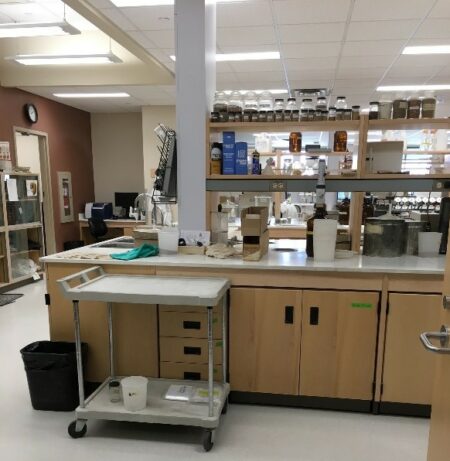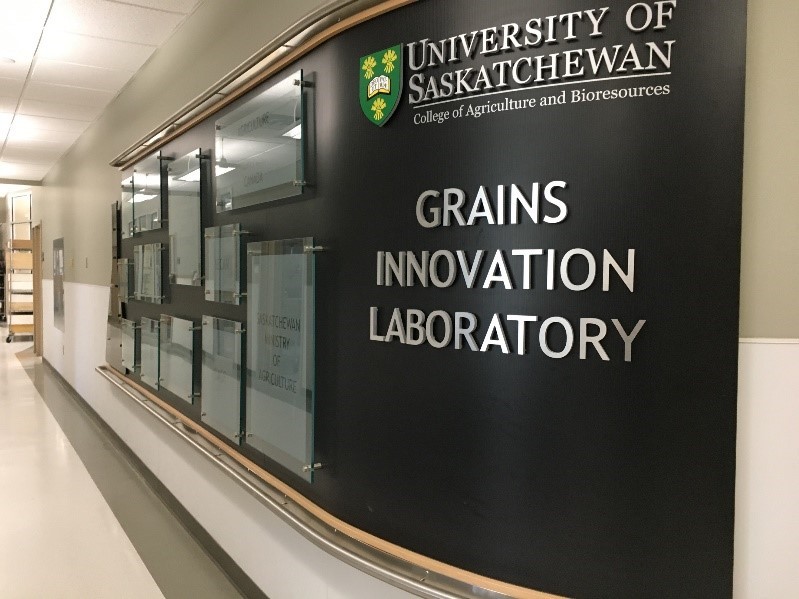Part 7: Varietal Testing at the U of S Grains Innovation Lab
This is the seventh of a series of #LabToField blogs that explain the yearly cycle of variety development. Click here to read Part 1: Phytotrons, Part 2: Agriculture Greenhouses, Part 3: The U of S Seed Lab, Part 4: Seeding, Part 5: Data Collection, or Part 6: Harvest
The U of S Grains Innovation Lab

The U of S Grains Innovation Lab (GIL) was opened in 2009 as part of an expansion to the Crop Science Field Facility. The GIL is a grain quality and screening laboratory and includes a Wet Chemistry Laboratory, Wheat/Durum Quality Laboratory, and Malting Barley Laboratory, as well as grinding and milling facilities. The state of the art equipment in the laboratory is used to test crop breeding lines for desired characteristics including nutrition, appearance, and functional end-use properties. While in-field analysis and data collection are very important in selecting potential crop varieties with desired agronomic traits, the GIL allows functional and nutritional qualities to also be considered in the varietal selection process.
Wet Chemistry Laboratory
Wet chemistry is a classical method of chemical analysis in their basic liquid forms used to isolate specific elements and compounds. The Wet Chemistry Laboratory at GIL’s allows for in-depth chemical analysis of the functional and nutritional properties of each potential new crop variety. This aids breeders in determining, on a chemical level, which varieties are best suited for their respective end-uses.

When analysing varieties in the early breeding stages, qualities such as protein are typically predicted using a NIR (Near Infrared Technology) machine and the least favourable lines are screened out. Analysis conducted on varieties farther along in the breeding process involves actually testing for desired qualities using high-tech equipment, such as the Leco protein analyzer, for selection purposes. Other pieces of specialized equipment in the lab include the Rapid Visco Analyzer (RVA) used to assess starch and fibre functionality and pre-harvest sprouting resistance, and the spectrophotometer which evaluates starch functionality and enzyme activity.
Wheat and Durum Quality Laboratory

The Wheat and Durum Quality Laboratory is used at multiple stages of the cereal crop breeding process and helps breeders evaluate potential crop varieties based on end-use suitability, such as baking, malting, or animal feed. Tests conducted in this section of the laboratory are focused on end-use functionality. One of the analyses conducted in this lab is the Falling Number Test used to evaluate sprout damage in wheat by determining how long it takes for a stirrer to fall through a heated sludge mixture. A high falling number indicates lower enzyme activity, and a low number indicates high activity and sprout-damaged wheat. Another test, the SDS-Sedimentation Test, provides an indication of potential baking quality. Varieties are also tested for gluten strength, which relates to the elasticity and expandability of the dough. Recently, the team at the GIL began testing gluten strength in early generational material to help screen out weaker varieties early on, which improves the efficiency of the whole process.
The Wheat and Durum Quality Laboratory is also where the wheat is milled into flour and baking tests are conducted on advanced breeding material. The flour is evaluated for parameters such as protein, colour, ash content, and baking qualities. It is then used to bake breads, cakes, and cookies to evaluate end-use suitability. The employees of the lab will sometimes bake over 20 loaves a day during their busiest seasons! Durum lines are also tested in this facility by making pasta products, and a special emphasis is placed on evaluating the flour’s yellow pigment, a highly desirable quality in pasta.
Influence on Canadian Agriculture
The Grains Innovation Lab supports the breeding line selection process by providing facilities for varietal evaluations to take place. The laboratory houses state-of-the-art equipment allowing for in-depth testing of the breeding lines, and combining this laboratory data with data collected in the field ensures that only the highest-quality lines advance to the next breeding stages. The high-tech laboratory equipment also improves the efficiency of the analysis, which allows the breeding line evaluation to advance as quickly as possible. Farmers benefit from the ability to grow crop varieties of the highest-quality containing the desired end-use properties tested for at the lab. The Grains Innovation Lab is just one small, but vital, part of the variety development process which ensures Canadian farmers are able to grow high-yielding, profitable crops for the industry.


